
Concept explainers
(a)
Interpretation:
The IUPAC name for the given compound is to be determined.
Concept introduction:
For a molecule that has more than one double bond or triple bond, the IUPAC name must indicate the number of double bonds or triple bonds present as well as their locations. To name the molecule with multiple double/triple bonds, establish the root as the longest carbon chain or the largest carbon ring that contains the greatest number of entire
Answer to Problem B.32P
The IUPAC name for the given compound is
Explanation of Solution
The given molecule is

In the given molecule, the longest carbon chain containing all
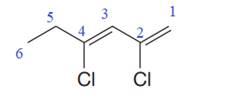
At carbon atoms C2 and C4 of the root, two chlorine atoms are present. Thus, the complete IUPAC name of this molecule is
The IUPAC name of the compound is written according to the rules for nomenclature.
(b)
Interpretation:
The IUPAC name for the given compound is to be determined.
Concept introduction:
For a molecule that has more than one double bond or triple bond, the IUPAC name must indicate the number of double bonds or triple bonds present as well as their locations. To name the molecule with multiple double/triple bonds, establish the root as the longest carbon chain or the largest carbon ring that contains the greatest number of entire
Answer to Problem B.32P
The IUPAC name for the given compound is
Explanation of Solution
The given compound is
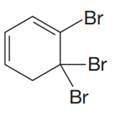
In the given molecule, the largest carbon ring containing all two
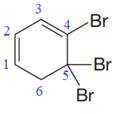
Three bromine atoms are present as substituents at carbon atoms C4, C5, and C5 to the root. The prefix ‘tri’ must be used to indicate the number of substituents present to the root. Thus, the complete IUPAC name of this molecule is
The IUPAC name of the compound is written according to the rules for nomenclature.
(c)
Interpretation:
The IUPAC name for the given compound is to be determined.
Concept introduction:
For a molecule that has more than one double bond or triple bond, the IUPAC name must indicate the number of double bonds or triple bonds present as well as their locations. To name the molecule with multiple double/triple bonds, establish the root as the longest carbon chain or the largest carbon ring that contains the greatest number of entire
Answer to Problem B.32P
The IUPAC name for the given compound is
Explanation of Solution
The given molecule is
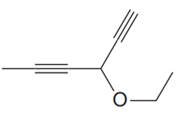
In the given molecule, the longest carbon chain containing all two
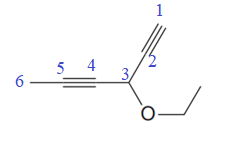
One methoxy substituent is attached to the C3 carbon atom of the root. Thus, the complete IUPAC name of this molecule is
The IUPAC name of the compound is written according to the rules for nomenclature.
(d)
Interpretation:
The IUPAC name for the given compound is to be determined.
Concept introduction:
For a molecule that has more than one double bond or triple bond, the IUPAC name must indicate the number of double bonds or triple bonds present as well as their locations. To name the molecule with multiple double/triple bonds, establish the root as the longest carbon chain or the largest carbon ring that contains the greatest number of entire
Answer to Problem B.32P
The IUPAC name for the given compound is
Explanation of Solution
The given molecule is

In the given molecule, the longest carbon chain containing all

At carbon atom C1of the root, one chlorine atom is present.
Thus, the complete IUPAC name of this molecule is
The IUPAC name of the compound is written according to the rules for nomenclature.
(e)
Interpretation:
The IUPAC name for the given compound is to be determined.
Concept introduction:
For a molecule that has more than one double bond or triple bond, the IUPAC name must indicate the number of double bonds or triple bonds present as well as their locations. To name the molecule with multiple double/triple bonds, establish the root as the longest carbon chain or the largest carbon ring that contains the greatest number of entire
Answer to Problem B.32P
The IUPAC name for the given compound is
Explanation of Solution
The given compound is
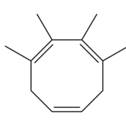
In the given molecule, the largest carbon ring containing all three
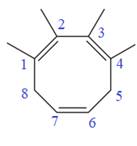
Four methyl substituents are attached at C1, C2, C3, and C4 carbon atoms of the root. The prefix ‘tetra’ should be used to indicate four methyl substituents.
Thus, the complete IUPAC name of this molecule is
The IUPAC name of the compound is written according to the rules for nomenclature.
(f)
Interpretation:
The IUPAC name for the given compound is to be determined.
Concept introduction:
For a molecule that has more than one double bond or triple bond, the IUPAC name must indicate the number of double bonds or triple bonds present as well as their locations. To name the molecule with multiple double/triple bonds, establish the root as the longest carbon chain or the largest carbon ring that contains the greatest number of entire
Answer to Problem B.32P
The IUPAC name for the given compound is
Explanation of Solution
The given molecule is
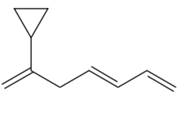
In the given molecule, the longest carbon chain containing all
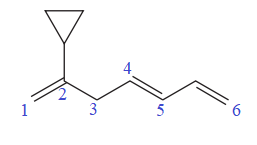
At carbon atom C2 of the root, one cyclopropyl group is attached.
Thus, the complete IUPAC name of this molecule is
The IUPAC name of the compound is written according to the rules for nomenclature.
(g)
Interpretation:
The IUPAC name for the given compound is to be determined.
Concept introduction:
For a molecule that has more than one double bond or triple bond, the IUPAC name must indicate the number of double bonds or triple bonds present as well as their locations. To name the molecule with multiple double/triple bonds, establish the root as the longest carbon chain or the largest carbon ring that contains the greatest number of entire
Answer to Problem B.32P
The IUPAC name for the given compound is
Explanation of Solution
The given molecule is

In the given molecule, the longest carbon chain containing all

There are no substituents attached to the root. Thus, the complete IUPAC name of this molecule is
The IUPAC name of the compound is written according to the rules for nomenclature.
Want to see more full solutions like this?
Chapter B Solutions
Organic Chemistry: Principles and Mechanisms (Second Edition)
- Epoxides can be opened in aqueous acid or aqueous base to produce diols (molecules with two OH groups). In this question, you'll explore the mechanism of epoxide opening in aqueous acid. 2nd attempt Be sure to show all four bonds at stereocenters using hash and wedge lines. 0 0 Draw curved arrows to show how the epoxide reacts with hydronium ion. 100 +1: 1st attempt Feedback Be sure to show all four bonds at stereocenters using hash and wedge lines. See Periodic Table See Hint H A 5 F F Hr See Periodic Table See Hintarrow_forward03 Question (1 point) For the reaction below, draw both of the major organic products. Be sure to consider stereochemistry. > 1. CH₂CH₂MgBr 2. H₂O 3rd attempt Draw all four bonds at chiral centers. Draw all stereoisomers formed. Draw the structures here. e 130 AN H See Periodic Table See Hint P C Brarrow_forwardYou may wish to address the following issues in your response if they are pertinent to the reaction(s) you propose to employ:1) Chemoselectivity (why this functional group and not another?) 2) Regioselectivity (why here and not there?) 3) Stereoselectivity (why this stereoisomer?) 4) Changes in oxidation state. Please make it in detail and draw it out too in what step what happens. Thank you for helping me!arrow_forward
- 1) Chemoselectivity (why this functional group and not another?) 2) Regioselectivity (why here and not there?) 3) Stereoselectivity (why this stereoisomer?) 4) Changes in oxidation state. Everything in detail and draw out and write it.arrow_forwardCalculating the pH at equivalence of a titration 3/5 Izabella A chemist titrates 120.0 mL of a 0.7191M dimethylamine ((CH3)2NH) solution with 0.5501 M HBr solution at 25 °C. Calculate the pH at equivalence. The pk of dimethylamine is 3.27. Round your answer to 2 decimal places. Note for advanced students: you may assume the total volume of the solution equals the initial volume plus the volume of HBr solution added. pH = ☐ ✓ 18 Ar Boarrow_forwardAlcohols can be synthesized using an acid-catalyzed hydration of an alkene. An alkene is combined with aqueous acid (e.. sulfuric acid in water). The reaction mechanism typically involves a carbocation intermediate. > 3rd attempt 3343 10 8 Draw arrows to show the reaction between the alkene and hydronium ion. that 2nd attempt Feedback 1st attempt تعمال Ju See Periodic Table See Hint F D Ju See Periodic Table See Hintarrow_forward
- Draw the simplified curved arrow mechanism for the reaction of acetone and CHgLi to give the major product. 4th attempt Π Draw the simplified curved arrow mechanism T 3rd attempt Feedback Ju See Periodic Table See Hint H -H H -I H F See Periodic Table See Hintarrow_forwardSelect the correct reagent to accomplish the first step of this reaction. Then draw a mechanism on the Grignard reagent using curved arrow notation to show how it is converted to the final product. 4th attempt Part 1 (0.5 point) Select the correct reagent to accomplish the first step of this reaction. Choose one: OA Mg in ethanol (EtOH) OB. 2 Li in THF O C. Li in THF D. Mg in THF O E Mg in H2O Part 2 (0.5 point) Br Part 1 Bri Mg CH B CH, 1 Draw intermediate here, but no arrows. © TE See Periodic Table See Hint See Hint ין Harrow_forwardSelect the product for the following reaction. HO HO PCC OH ○ OH O HO ○ HO HO HOarrow_forward
- 5:45 Х Select the final product for the following reaction sequence. O O 1. Mg. ether 2.D.Oarrow_forwardBased on the chart Two similarities between the molecule with alpha glycosidic linkages. Two similarities between the molecules with beta glycosidtic linkages. Two differences between the alpha and beta glycosidic linkages.arrow_forwardplease help fill in the tablearrow_forward
 Introductory Chemistry: An Active Learning Approa...ChemistryISBN:9781305079250Author:Mark S. Cracolice, Ed PetersPublisher:Cengage Learning
Introductory Chemistry: An Active Learning Approa...ChemistryISBN:9781305079250Author:Mark S. Cracolice, Ed PetersPublisher:Cengage Learning

